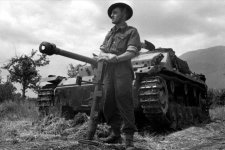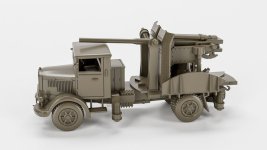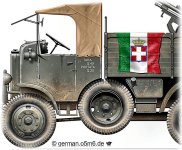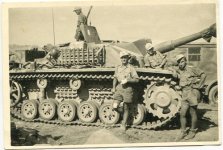- Joined
- Feb 2, 2011
- Messages
- 2,339
NEW RELEASES FOR OCTOBER 2025
THE SECOND WORLD WAR
GERMAN ARMOUR
Italy... the Forgotten Front!
While most World War Two enthusiasts focus on either the Normandy Campaign or the Eastern Front, the Italian Theatre was no less important in 1944 to the outcome of the war. Following their victory in North Africa, the Allies launched a campaign to weaken the Axis by knocking Italy out of the war. Allied planners originally envisioned a relatively easy operation to carve out the "soft underbelly" of Europe. Instead, they encountered a "tough old gut" filled with battle-hardened German troops, turning the theatre into a grueling campaign that stretched the length of the Italian peninsula.
Here, Allied offensives were repeatedly rebuffed in brutal fighting, nowhere more so than at the Allied landings at Anzio and during the multiple battles for Monte Cassino and the Gustav Line. Fighting in Italy continued until the very end of the war and proved to be the bloodiest campaign on the Western Front, with combined Allied and German infantry casualties exceeding 300,000.

John Jenkins Designs' newest releases focus on this often-overlooked area of World War Two, with a matched pair of assault guns representing a StuG III Ausf. G and a StuH 42 Sturmhaubitze (Assault Howitzer) of StuG Brigade 242.

GA-24A
THE SECOND WORLD WAR,
StuG III Ausf. G Assault Gun (Sd.Kfz. 142/1)
Sturmgeschütz Brigade 242
Italy – The Forgotten Front
Monte Cassino, January–May 1944.
(Box size 7” x 4 ½” x 10 ½” Weight 800g)
StuG Abteilung 242 was originally formed in November 1942 and was intended for deployment in North Africa, where Generaloberst Erwin Rommel was eager to add its firepower to Panzerarmee Afrika. However, the Desert Fox only partially got his wish: only the 1. Batterie was sent to Africa, where it was attached to the 10. Panzer-Division and fought until the German surrender in Tunisia.

The other two StuG batteries were diverted at the last minute to the Eastern Front following the collapse at Stalingrad, where they suffered heavy casualties fighting brutal delaying actions. Pulled from Russia in early 1943, the 2nd and 3rd Batteries were reorganized, re-equipped, and then sent to Sardinia, Italy.

In Sardinia, StuG Abteilung 242 was attached to the 90. leichte "Afrika" Division and formed a German rearguard until the island was abandoned in September 1943. The battalion was then sent to Corsica, where it again covered the German retreat to mainland Italy.
At the beginning of 1944, StuG Abteilung 242 was deployed to the southern Italian sector, where the unit saw action in all the major engagements of the four battles for Monte Cassino, which raged from 17 January to 18 May 1944. The unit served as a mobile "fire brigade" for the sector, with its assault gun batteries dispatched to the fiercest points of combat, helping to keep the vitally important Monte Cassino in German hands, which served as a linchpin for Field Marshal Kesselring's defense of the Gustav Line.
During this period, StuG Abteilung 242 was subsequently attached to the 94. Infanterie-Division, 44. Infanterie-Division "Hoch und Deutschmeister", the "Hermann Göring" Division, and the 1. Fallschirmjäger Division. Additionally, on 14 February 1944 the unit was officially redesignated as StuG Brigade 242.
StuG Brigade 242's most famous action occurred while attached to the 1. Fallschirmjäger Division. Its StuG III assault guns directly supported the German paratroopers as they fought amidst the rubble of Cassino and the ruins of the historic Monte Cassino Abbey, which had been destroyed by Allied bombers in one of the most controversial decisions of the war.
One particular StuG III from the brigade proved especially troublesome for the Allies. It was positioned in the main hall of the destroyed Excelsior Hotel, where it sheltered from Allied bombing and artillery strikes, only to emerge when needed to repel Allied tanks. Famous video footage of the fighting involving StuG Brigade 242 can be found in German Wochenschau newsreel episodes.

GA-24B
THE SECOND WORLD WAR,
StuH 42 Assault Howitzer (Sd.Kfz. 142/2)
Sturmgeschütz Brigade 242
Italy – The Forgotten Front
Monte Cassino, January–May 1944.
(Box size 7” x 4 ½” x 10 ½” Weight 820g)
Other StuG IIIs and StuH 42s from the brigade defended the vital area southwest of Cassino, enabling the Fallschirmjäger to hold out for an extended period. Altogether, the battles for Monte Cassino and the Gustav Line involved approximately 240,000 Allied troops and resulted in 55,000 Allied casualties. The Germans suffered approximately 20,000 casualties out of the 140,000 troops they committed.
The new John Jenkins Designs StuG III Ausf. G and StuH 42 represent an assault gun and assault howitzer of StuG Brigade 242 during the fighting at Monte Cassino. While collectors are likely familiar with the StuG III Ausf G armed with a 7.5cm StuK 40 cannon, the StuH 42 is a new addition to the 1/30 scale hobby.

By late 1942, the StuG III had effectively evolved from a direct infantry support weapon into a tank destroyer...a role at which it excelled, ultimately becoming the deadliest German AFV of the war, with the most Allied tank kills. As a result, the StuH 42 was introduced to restore assault gun units’ ability to support infantry, their original mission.

The StuH 42 was essentially identical to the StuG III Ausf. G except for its main armament. While the StuG III Ausf. G's 7.5cm StuK 40 cannon was primarily designed to kill Allied tanks, the StuH 42's 10.5 cm StuH L/28 howitzer, adapted from the proven 10.5 cm leFH 18 light field howitzer, was primarily designed for direct support of infantry. In this role, the excellent blast and shrapnel effects of the StuH 42's larger howitzer quickly proved highly effective against massed infantry formations, bunkers, and strongpoints. Allied troops came to respect the StuH 42 as a feared "infantry killer."
Together, the combination of StuG III assault guns and StuH 42 howitzers gave a StuG Brigade excellent tactical mobility, capable of performing both anti-tank and infantry support roles as needed. This potent combination enabled StuG Brigades to stiffen the resolve and increase the combat effectiveness of any infantry division they were attached to.
The John Jenkins Designs "Monte Cassino" StuG III Ausf. G and StuH 42 have the following features:
- Historically accurate unit modifications for StuG Brigade 242:
- Schürzen sideskirt frame mounts but no schürzen rails or panels, as StuG Brigade 242 did not use them around Monte Cassino
- Track links on the hull sides between the schürzen mounting frames
- Track links on the StuH 42 hull between the tracks/running gear
- StuG Brigade 242 unit markings
- Solid Dunkelgelb/Dark Yellow paint jobs with dusty weathering seen on many of StuG Brigade 242's vehicles in Italy
- All hatches open and close
- Detailed interior and detailed engine bays

GA-24AB
THE SECOND WORLD WAR,
StuG III Ausf. G Assault Gun (Sd.Kfz. 142/1) and
StuH 42 Assault Howitzer (Sd.Kfz. 142/2),
Sturmgeschütz Brigade 242
Italy – The Forgotten Front
Monte Cassino, January–May 1944.
SPECIAL OFFER FOR OCTOBER ONLY.
Many Thanks to Steve “Hunter Rose”.
**PLEASE CONTACT YOUR LOCAL DEALER TO PLACE YOUR PRE-ORDERS**
THE SECOND WORLD WAR
GERMAN ARMOUR
Italy... the Forgotten Front!
While most World War Two enthusiasts focus on either the Normandy Campaign or the Eastern Front, the Italian Theatre was no less important in 1944 to the outcome of the war. Following their victory in North Africa, the Allies launched a campaign to weaken the Axis by knocking Italy out of the war. Allied planners originally envisioned a relatively easy operation to carve out the "soft underbelly" of Europe. Instead, they encountered a "tough old gut" filled with battle-hardened German troops, turning the theatre into a grueling campaign that stretched the length of the Italian peninsula.
Here, Allied offensives were repeatedly rebuffed in brutal fighting, nowhere more so than at the Allied landings at Anzio and during the multiple battles for Monte Cassino and the Gustav Line. Fighting in Italy continued until the very end of the war and proved to be the bloodiest campaign on the Western Front, with combined Allied and German infantry casualties exceeding 300,000.

John Jenkins Designs' newest releases focus on this often-overlooked area of World War Two, with a matched pair of assault guns representing a StuG III Ausf. G and a StuH 42 Sturmhaubitze (Assault Howitzer) of StuG Brigade 242.

GA-24A
THE SECOND WORLD WAR,
StuG III Ausf. G Assault Gun (Sd.Kfz. 142/1)
Sturmgeschütz Brigade 242
Italy – The Forgotten Front
Monte Cassino, January–May 1944.
(Box size 7” x 4 ½” x 10 ½” Weight 800g)
StuG Abteilung 242 was originally formed in November 1942 and was intended for deployment in North Africa, where Generaloberst Erwin Rommel was eager to add its firepower to Panzerarmee Afrika. However, the Desert Fox only partially got his wish: only the 1. Batterie was sent to Africa, where it was attached to the 10. Panzer-Division and fought until the German surrender in Tunisia.

The other two StuG batteries were diverted at the last minute to the Eastern Front following the collapse at Stalingrad, where they suffered heavy casualties fighting brutal delaying actions. Pulled from Russia in early 1943, the 2nd and 3rd Batteries were reorganized, re-equipped, and then sent to Sardinia, Italy.

In Sardinia, StuG Abteilung 242 was attached to the 90. leichte "Afrika" Division and formed a German rearguard until the island was abandoned in September 1943. The battalion was then sent to Corsica, where it again covered the German retreat to mainland Italy.
At the beginning of 1944, StuG Abteilung 242 was deployed to the southern Italian sector, where the unit saw action in all the major engagements of the four battles for Monte Cassino, which raged from 17 January to 18 May 1944. The unit served as a mobile "fire brigade" for the sector, with its assault gun batteries dispatched to the fiercest points of combat, helping to keep the vitally important Monte Cassino in German hands, which served as a linchpin for Field Marshal Kesselring's defense of the Gustav Line.
During this period, StuG Abteilung 242 was subsequently attached to the 94. Infanterie-Division, 44. Infanterie-Division "Hoch und Deutschmeister", the "Hermann Göring" Division, and the 1. Fallschirmjäger Division. Additionally, on 14 February 1944 the unit was officially redesignated as StuG Brigade 242.
StuG Brigade 242's most famous action occurred while attached to the 1. Fallschirmjäger Division. Its StuG III assault guns directly supported the German paratroopers as they fought amidst the rubble of Cassino and the ruins of the historic Monte Cassino Abbey, which had been destroyed by Allied bombers in one of the most controversial decisions of the war.
One particular StuG III from the brigade proved especially troublesome for the Allies. It was positioned in the main hall of the destroyed Excelsior Hotel, where it sheltered from Allied bombing and artillery strikes, only to emerge when needed to repel Allied tanks. Famous video footage of the fighting involving StuG Brigade 242 can be found in German Wochenschau newsreel episodes.

GA-24B
THE SECOND WORLD WAR,
StuH 42 Assault Howitzer (Sd.Kfz. 142/2)
Sturmgeschütz Brigade 242
Italy – The Forgotten Front
Monte Cassino, January–May 1944.
(Box size 7” x 4 ½” x 10 ½” Weight 820g)
Other StuG IIIs and StuH 42s from the brigade defended the vital area southwest of Cassino, enabling the Fallschirmjäger to hold out for an extended period. Altogether, the battles for Monte Cassino and the Gustav Line involved approximately 240,000 Allied troops and resulted in 55,000 Allied casualties. The Germans suffered approximately 20,000 casualties out of the 140,000 troops they committed.
The new John Jenkins Designs StuG III Ausf. G and StuH 42 represent an assault gun and assault howitzer of StuG Brigade 242 during the fighting at Monte Cassino. While collectors are likely familiar with the StuG III Ausf G armed with a 7.5cm StuK 40 cannon, the StuH 42 is a new addition to the 1/30 scale hobby.

By late 1942, the StuG III had effectively evolved from a direct infantry support weapon into a tank destroyer...a role at which it excelled, ultimately becoming the deadliest German AFV of the war, with the most Allied tank kills. As a result, the StuH 42 was introduced to restore assault gun units’ ability to support infantry, their original mission.

The StuH 42 was essentially identical to the StuG III Ausf. G except for its main armament. While the StuG III Ausf. G's 7.5cm StuK 40 cannon was primarily designed to kill Allied tanks, the StuH 42's 10.5 cm StuH L/28 howitzer, adapted from the proven 10.5 cm leFH 18 light field howitzer, was primarily designed for direct support of infantry. In this role, the excellent blast and shrapnel effects of the StuH 42's larger howitzer quickly proved highly effective against massed infantry formations, bunkers, and strongpoints. Allied troops came to respect the StuH 42 as a feared "infantry killer."
Together, the combination of StuG III assault guns and StuH 42 howitzers gave a StuG Brigade excellent tactical mobility, capable of performing both anti-tank and infantry support roles as needed. This potent combination enabled StuG Brigades to stiffen the resolve and increase the combat effectiveness of any infantry division they were attached to.
The John Jenkins Designs "Monte Cassino" StuG III Ausf. G and StuH 42 have the following features:
- Historically accurate unit modifications for StuG Brigade 242:
- Schürzen sideskirt frame mounts but no schürzen rails or panels, as StuG Brigade 242 did not use them around Monte Cassino
- Track links on the hull sides between the schürzen mounting frames
- Track links on the StuH 42 hull between the tracks/running gear
- StuG Brigade 242 unit markings
- Solid Dunkelgelb/Dark Yellow paint jobs with dusty weathering seen on many of StuG Brigade 242's vehicles in Italy
- All hatches open and close
- Detailed interior and detailed engine bays

GA-24AB
THE SECOND WORLD WAR,
StuG III Ausf. G Assault Gun (Sd.Kfz. 142/1) and
StuH 42 Assault Howitzer (Sd.Kfz. 142/2),
Sturmgeschütz Brigade 242
Italy – The Forgotten Front
Monte Cassino, January–May 1944.
SPECIAL OFFER FOR OCTOBER ONLY.
Many Thanks to Steve “Hunter Rose”.
**PLEASE CONTACT YOUR LOCAL DEALER TO PLACE YOUR PRE-ORDERS**






